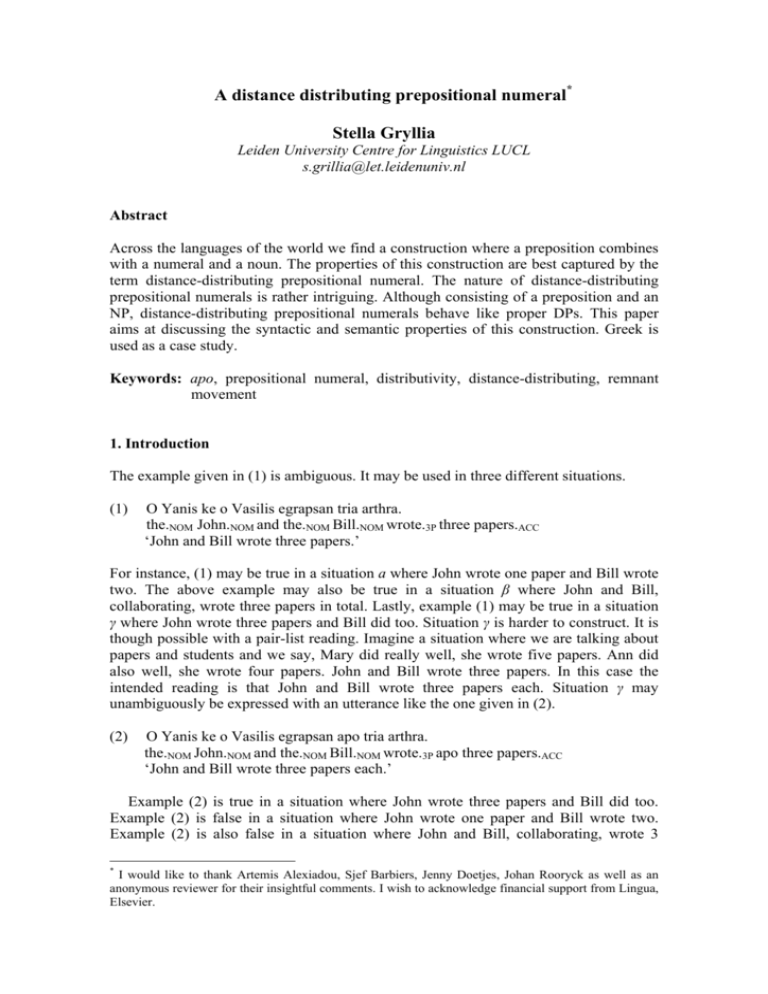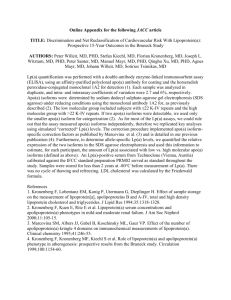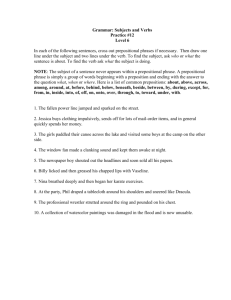A distance distributing prepositional numeral* Stella Gryllia
advertisement

A distance distributing prepositional numeral* Stella Gryllia Leiden University Centre for Linguistics LUCL s.grillia@let.leidenuniv.nl Abstract Across the languages of the world we find a construction where a preposition combines with a numeral and a noun. The properties of this construction are best captured by the term distance-distributing prepositional numeral. The nature of distance-distributing prepositional numerals is rather intriguing. Although consisting of a preposition and an NP, distance-distributing prepositional numerals behave like proper DPs. This paper aims at discussing the syntactic and semantic properties of this construction. Greek is used as a case study. Keywords: apo, prepositional numeral, distributivity, distance-distributing, remnant movement 1. Introduction The example given in (1) is ambiguous. It may be used in three different situations. (1) O Yanis ke o Vasilis egrapsan tria arthra. the.NOM John.NOM and the.NOM Bill.NOM wrote.3P three papers.ACC ‘John and Bill wrote three papers.’ For instance, (1) may be true in a situation a where John wrote one paper and Bill wrote two. The above example may also be true in a situation β where John and Bill, collaborating, wrote three papers in total. Lastly, example (1) may be true in a situation γ where John wrote three papers and Bill did too. Situation γ is harder to construct. It is though possible with a pair-list reading. Imagine a situation where we are talking about papers and students and we say, Mary did really well, she wrote five papers. Ann did also well, she wrote four papers. John and Bill wrote three papers. In this case the intended reading is that John and Bill wrote three papers each. Situation γ may unambiguously be expressed with an utterance like the one given in (2). (2) O Yanis ke o Vasilis egrapsan apo tria arthra. the.NOM John.NOM and the.NOM Bill.NOM wrote.3P apo three papers.ACC ‘John and Bill wrote three papers each.’ Example (2) is true in a situation where John wrote three papers and Bill did too. Example (2) is false in a situation where John wrote one paper and Bill wrote two. Example (2) is also false in a situation where John and Bill, collaborating, wrote 3 * I would like to thank Artemis Alexiadou, Sjef Barbiers, Jenny Doetjes, Johan Rooryck as well as an anonymous reviewer for their insightful comments. I wish to acknowledge financial support from Lingua, Elsevier. 118 Stella Gryllia papers (collective interpretation). Thus, the predicate in example (2) can only receive a distributive interpretation. The aim of this paper is to discuss the construction presented in (2) providing a syntactic and a semantic account. As will be made explicit in section 2, the term distance- distributing prepositional numeral best captures the construction in (2). The paper is organized as follows. Section 2 discusses the nature of the apo distancedistributing prepositional numeral. Section 3 demonstrates the properties of the internal structure of the apo distance-distributing prepositional numeral. Section 4 outlines its semantic properties and in section 5 certain conclusions are drawn. 2. Apo prepositional numeral: PP or DP Apo has been described as a preposition (see, among others, Triantafyllidis 1981; Holton et al. 1999). Apo combines with DPs (see, among others, TheophanopoulouKontou 1992) and it expresses a wide variety of meanings. Apo apart from expressing temporal, causal and spatial relations can also be used as a by-phrase (see, among others, Alexiadou & Anagnostopoulou 1999). Finally, as already shown in example (2), apo can combine with a numeral and a noun. This combination results in a distributive interpretation of the predicate. For this type of combination, I will use the cover term distance-distributing prepositional numeral along the lines of Plank (2004) and Corver & Zwarts (2004). Examples (3) and (4) demonstrate a basic property of distance-distributing prepositional numerals. The preposition apo and the numeral form a strong unit. In this respect, it is not possible to insert a definite determiner between the preposition and the numeral and still maintain the distributive interpretation. As shown in example (3), the insertion of a definite determiner leads either to ungrammaticality (3a) or to loss of the distributive interpretation (3b). The predicate in (3b) cannot be interpreted distributively. Example (3b) receives a kind of partitive interpretation; it means that John and Bill read some pages from the three books. (3a) *O Yanis ke o Vasilis egrapsan apo ta tria arthra. the.NOM John.NOM and the.NOM Bill.NOM wrote.3P apo the three papers.ACC ‘John and Bill wrote the three papers each.’ (3b) O Yanis ke o Vasilis diavasan apo ta tria vivlia. the.NOM John.NOM and the.NOM Bill.NOM read.3P apo the three books.ACC ‘John and Bill read some pages from the three books.’ (* distributive / √ partitive) (4) O Yanis ke o Vasilis diavasan apo tria vivlia. the.NOM John.NOM and the.NOM Bill.NOM read.3P apo three books.ACC ‘John and Bill read three books each.’ As already said, the predicate in (3b) receives a partitive interpretation, whereas the predicate in (4) is interpreted distributively. A question that arises is whether examples (3b) and (4) differ syntactically as well. In this section, I will argue that in (4) we are dealing with a prepositional numeral that behaves like a DP, whereas the structure in (3b) is a proper prepositional phrase. The examples I give are from Greek. Distancedistributing prepositional numerals, however, are attested in other languages as well. The interested reader is referred to Appendix A. Let us examine the distribution of the apo prepositional numeral in the clause. As illustrated in examples (5)-(9), its distribution is rather restricted. It can only appear in a direct object position, as indicated by example (5). It cannot appear in an indirect object A distance distributing prepositional numeral 119 position, as shown by examples (6) and (7). It cannot, unless restricted 1 , appear in subject position, as exemplified in (8) and (9). (5) (6) (7) (8) (9) O Yanis ke o Vasilis egrapsan apo tria arthra. the.NOM John.NOM and the.NOM Bill.NOM wrote.3P apo three papers.ACC ‘John and Bill wrote three papers each.’ *Edosa apo se dio pedia dio vivlia. gave.1S apo to two children two books.ACC ‘I gave two children two books each.’ *I kathigites didaksan apo dio pedia kanones grammatikis. the.NOM teachers.NOM taught apo two children rules grammar ‘The teachers taught grammar rules to two children each.’ *Apo dio mathites zografisan ena dendro. apo two pupils.NOM drew.3P a tree ‘Two boys drew a tree each.’ Apo dio mathites se kathe taksi zografisan ena dendro. apo two pupils.NOM in every class drew.3P a tree ‘In every class, two pupils drew a tree.’ Note that in (9) the prepositional numeral is distributed over its restriction se kathe taksi, so from every class of the domain of discourse two pupils are selected. The plural subject is not distributed over the predicate. It is impossible to get a reading where each of these two pupils drew a tree on its own2. Having explored the distribution of apo prepositional numeral let us focus on the question about its PP or DP nature. The evidence for its DP nature comes from two sources. First, the constituency tests show that apo prepositional numeral behaves like a proper DP. Second, its split properties pattern with the split properties of DPs. Examples (10) to (14) show the results of the constituency tests. First, it can be passivized. (10) Apo dio dora dothikan sta pedia. apo two presents.ACC were given to-the children ‘Each of the children was given two presents.’ Second, it can be preposed. (11) Apo pente vivlia agorasa sta pedia. apo five books.ACC bought.1S to-the children ‘Five books each, bought I for the children.’ Thirdly, it can be coordinated. (12a) Ta pedia agorasan vivlia ke apo pente sokolates. the.NOM children.NOM bought.3P books and apo five chocolates.ACC ‘The children bought books and five chocolates each.’ (12b) *Ta pedia agorasan vivlia ke sta pedia. the.NOM children.NOM bought.3P books and to-the children 1 The restriction in this case provides the domain of discourse with respect to which the quantificational statement is interpreted (Schwarzschild 2002). 2 I wish to thank A.Dimitriadis for pointing this out to me. Stella Gryllia 120 ‘The children bought books and to the children.’ Fourthly, it can appear in pseudoclefts. (13) Afto pu efagan ta pedia ine apo pente sokolates. This that ate.3P the.NOM children.NOM is apo five chocolates.ACC ‘What the children ate is five chocolates each.’ Lastly, it can be used as a fragment answer to a question. (14a) Ti agorasan ta pedia? what bought.3P the.NOM children.NOM ‘What did the children buy? ’ (14b) Apo pente sokolatakia. apo five chocolates ‘Five chocolates each.’ The DP nature of the prepositional numeral is supported from its split properties. The apo prepositional numeral splits like a DP. The split properties of the DP are indicated in example (15). The data are from Androutsopoulou (1998). The split properties of the apo prepositional numeral are depicted in (16). Comparing examples (15) and (16) we see that there is a parallel with respect to split. The split properties of the prepositional numeral seem to pattern with the split properties of the DP. Split properties of DPs (15a) Agorasa to kokino forema. Bought.1S the.ACC red.ACC dress.ACC ‘I bought the red dress.’ (15b) To kokino agorasa forema. the.ACC red.ACC bought.1S dress.ACC ‘It is the red dress that I bought.’ (15c) Forema, agorasa to kokino. dress.ACC bought.1S the.ACC red.ACC ‘As for the dress, I bought the red one.’ Split properties of the prepositional numeral (16a) Grapsame apo dio arthra. wrote.3P apo two papers.ACC ‘We wrote two papers each’ (16b) Apo dio grapsame arthra. apo two wrote.3P papers.ACC ‘It is two papers we wrote each.’ (16c) Arthra, grapsame apo dio. papers.ACC wrote.3P apo two ‘As for the papers, we wrote two each.’ A distance distributing prepositional numeral 121 The picture becomes more explicit when looking at the split properties of the PPs. The PPs cannot split, as shown in example (17)3. (17a) Milisa se dio filus. talked.1S to two friends.ACC ‘I talked to two friends.’ (17b) *Se dio milisa filus. to two talked.1S friends.ACC ‘I talked to two friends.’ (17c) *Filus, milisa se dio. friends.ACC talked.1S to two ‘I talked to two friends.’ Summarizing, in this section, I argued for the DP nature of the apo prepositional numeral. Evidence for this claim came from the constituency tests and the split properties of the apo prepositional numeral. 3. The internal structure of the apo prepositional numeral In this section, I discuss the internal structure of the apo prepositional numeral. Based mainly on its split properties, I propose that apo is hosted in the Specifier of NumP4, assuming that the numeral is hosted in Num0 (see, among others, Alexiadou 2001). The proposed structure is depicted in (18). (18) DP D' NumP Num' apo dio N For convenience, I repeat the split properties of the apo prepositional numeral in (19). (19a) Grapsame apo dio arthra. wrote.1P apo two papers.ACC ‘We wrote two papers each.’ (19b) Apo dio grapsame arthra. apo two wrote.1P papers.ACC ‘It is two papers we wrote each.’ (19c) Arthra, grapsame apo dio. papers.ACC wrote.1P apo two ‘As for the papers, we wrote two each.’ 3 An anonymous reviewer points out that he finds (17b) better than (17c). The reason is unclear to me. If (17b) is judged as marginally acceptable, then the crucial point will be the contrast between (16c) and (17b). 4 An anonymous reviewer asks why apo is hosted in SpecNumP and not directly in D. I assume that if apo was hosted in D, then we would expect a semantic effect, namely specificity. However, the sequence apo numeral noun is not interpreted as specific. Stella Gryllia 122 Note that (19b) and (19c) differ with respect to their information structure. In (19b) apo dio is interpreted as the focus of the sentence and a focus intonation is required, whereas in (19c) arthra is interpreted as a topic and a topic intonation is required. The structure in (19b) is derived via two movements, the first one feeding the second. The noun arthra moves first to a left DP peripheral position, as shown in (20a). At this point I follow Ntelitheos (2003) who argues for a left periphery of the DP. Then the noun phrase moves with remnant movement to a clausal left peripheral position, where it receives the focus interpretation, as indicated in (20b). (20a) (20b) DP FP D' DP D' NumP NumP Num' arthrai apo arthrai apo ti dio Num' The structure in (19c) is derived via two movements, the first one being an intermediate movement. The noun arthra moves first to a left DP peripheral position, as shown in (21a). In this case D serves as an escape hatch for topicalization (see among others Horrocks & Stavrou 1987). Arthra moves then to a position in the left periphery of the clause, namely to TopicP where it is interpreted as a topic, as indicated in (21b). (21a) DP (21b) D' NumP Num' arthrai apo ti dio TopP DP D' NumP arthrai apo Num' dio ti An alternative structure to the one presented in (20a) and (21a) would be to assume that apo and the numeral form a complex head that is hosted at Num0, as is shown in (22). (22) DP D' apo NumP Num' dio N A distance distributing prepositional numeral 123 One might consider that example (23) gives evidence for the structure in (22). (23a) *Apo grapsame dio arthra. apo wrote.1P two papers.ACC ‘We wrote two papers each.’ (23b) *Dio arthra grapsame apo. two papers.ACC wrote.1P apo ‘We wrote two papers each.’ I think that the ungrammaticality of (23a) and (23b) is due to independent reasons. Thus, (23) cannot be used as an argument for the structure in (22). Moreover, there is an argument against the structure in (22) coming from the focus sensitive operators. Examples are given in (24) and (25). In these examples the focus sensitive operators sxedon and molis modify the numeral in the apo prepositional numeral construction. (24) ok/?/*Grapsame apo sxedon dio arthra. wrote.1P apo almost two papers.ACC ‘We wrote almost two papers each.’ (25) ok/?/*Grapsame apo molis dio arthra. wrote.1P apo just two papers.ACC ‘We wrote just two papers each.’ It should be noted that there is disagreement among speakers with respect to the status of (24) and (25) 5 . Some speakers find examples (24) and (25) grammatical. These examples being grammatical, they pose a problem for a complex head analysis. Under a complex head analysis, there is nothing that can intervene between the two formants of the complex head. Therefore, I assume that the apo prepositional numeral has the structure depicted in (20a) and (21a). 4. The semantics of the apo prepositional numeral In section 2, it was said that apo combines with a numeral and a noun functioning in this way as a distributive marker. In this section, I discuss the distributive interpretation of the apo prepositional numeral. Let us consider example (26). Example (26) is true in a situation where John and Bill are watching three movies each. A question that emerges is whether (26) can be interpreted as involving six different movies. If this question is answered positively, then it could be argued that the semantics of apo prepositional numeral is similar to the semantics of different (Carlson 1987; Moltmann 1992; Beck 2000). (26) O Yanis ke o Vasilis idan apo tris tenies. the.NOM John.NOM and the.NOM Bill.NOM saw.3P apo three movies ‘John and Bill saw three movies each.’ However, the answer to this question is no, as example (26) is true in a situation where John saw movies α, β and γ and Bill saw movies β, γ and δ. Thus, the semantics of the apo prepositional numeral differ from the semantics of different. 5 In my sample that consists of 30 speakers, 20 speakers judged (24) and (25) as grammatical, 5 speakers found the sentences marginally acceptable and 5 speakers found them ungrammatical. Stella Gryllia 124 It seems that the meaning of apo prepositional numeral is similar to the meaning of the binominal each (see, among others, Safir & Stowell 1989; Zimmermann 2000). However, this is not absolutely true. Returning to example (26), we see that apo prepositional numeral behaves reversely. Contrary to what one might expect, in (26), it is the plural coordinated DP, John and Bill that is distributed over the predicate saw three movies. In this sense apo is distributing at a distance. It is not the predicate that is distributed over the coordinated DP, but the other way round. Recall from the discussion in the introduction that the distributive reading is due to the presence of apo. It is apo that triggers a distributive phrase in the clause. The distributive interpretation is obtained via the movement of the plural DP to the Specifier of DistP (Beghelli & Stowell 1996),as in example (27). Apo in this respect distance-distributes. (27) RefP CP AgrS DistP ShareP NegP AgrOP 5. Concluding remarks Summarizing, it can be concluded that the apo prepositional numeral has a DP nature and attributes a distributive interpretation. Apo functions as a distributive trigger. Taking into consideration the fact that apo can express other relations as well, e.g. causal, temporal, spatial, it would be interesting to see to which extent all these meanings can be derived from a single lexical entry. It is also worth investigating the extent to which the languages that share the same construction attest the same split properties. I leave these issues open for further research. References Alexiadou, A. (2001). Functional Structure in Nominals. Amsterdam: John Benjamins. Alexiadou, A. & E. Anagnostopoulou (1999). “Non-Active morphology and the direction of transitivity alternations”. NELS 29: 27-40. Androutsopoulou, A. (1998). “Split DPs, Focus and Scrambling in Modern Greek”. WCCFL 16, 1-16. Beck, S. (2000). “The semantics of different: comparison operator and relational adjective”. Linguistics and Philosophy 23: 101-139. Carlson, G. (1987). “Same and different: some consequences for syntax and semantics”. Linguistics and Philosophy 10: 531-566. Beghelli, F. & T. Stowell (1996). “Distributivity and Negation: The syntax of each and every”. In A. Szabolcsi (ed.), Ways of Scope Taking. Dordrecht: Kluwer, 71-107. Choe, J.-W. (1987). Anti-Quantifiers and a Theory of Distributivity. Doctoral dissertation, UMass, Amherst. Corver, N. & J. Zwarts (2004). “Prepositional Numerals”. Paper presented at the Linguistics in the Netherlands meeting, Utrecht, and the Workshop on Numerals in the World’s Languages, Leipzig. Holton D., P. Mackridge & I. Philippaki-Warburton (1999). Γραµµατική της ελληνικής γλώσσας (µτφρ. Β. Σπυρόπουλος). Αθήνα: Πατάκης. A distance distributing prepositional numeral 125 Horrocks, G. & M. Stavrou (1987). “Bounding theory and Greek syntax: evidence for wh-movement in NP”. Journal of Linguistics 23: 79-108. Moltmann, F. (1992). “Reciprocals and same/different: towards a semantic analysis”. Linguistics and Philosophy 15: 411-462. Ntelitheos, D. (2003). “The Syntax of Emphasis: Split DPs and Nominal Ellipsis”. Proceedings of the 6th International Conference of Greek Linguistics, Department of Philology, University of Crete, Rethymno, Greece. Available at: http://www.philology.uoc.gr/conferences/6thICGL/ebook/. Plank, F. (2004). “Inevitable reanalysis: From local adpositions to approxiamative adnumerals, in German and wherever”. Studies in Language 28: 165-201 Safir, K. & T. Stowell (1989). “Binominal each”. NELS 18: 426-450. Schwarzschild, R. (2002). “Singleton Indefinites”. Journal of Semantics 19: 289-314. Theofanopoulou-Kontou D. (1992). “Οι σύνθετες προθετικές φράσεις της Νέας Ελληνικής και η δοµή τους”. Proceedings of the 13th Annual Meeting of the Department of Linguistics. University of Thessaloniki, 311-331. Τriantafillidis, Μ. (1981). Νεοελληνική Γραµµατική της δηµοτικής, 3η έκδοση. Θεσσαλονίκη: Ινστιτούτο Νεοελληνικών Σπουδών, Ίδρυµα Μανόλη Τριανταφυλλίδη. Zimmermann, M. (2002). Boys buying two sausages each: on the syntax and semantics of distance distributivity. LOT Dissertation Series 62. 126 Stella Gryllia Appendix A SERBO-CROATIAN (1) Dao sam momcima po dve jabuke. given AUX.1S boys po two apples ‘I gave the boys two apples each.’ BULGARIAN (2) Izjadohme po dve jabəlki. ate.1P po two apples ‘We ate two apples each.’ POLISH (3) Zjedliśmy po dwa jablka. ate.1P po two apples ‘We ate two apples each.’ RUSSIAN (4) Ja dal malchikam po dva jabloka. I gave the boys po two apples ‘I gave the boys two apples each.’






